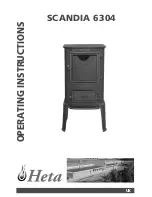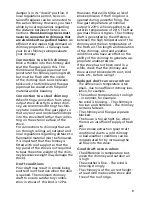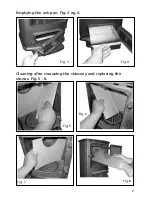
6
This may result in the production of
large volumes of gas, and this gas can
explode if the intake of primary and
secondary air is insufficient.
It is an advantage always to leave
some ash lying in the bottom of the
combustion chamber.
Take care when emptying the ash pan,
as cinders can continue to burn in the
ash for long periods of time.
OPERATIONAL PROBLEMS
fit a damper in the flue gas pipe to
regulate the draft. When cleaning the
chimney, soot and other deposits may
come to fall on the smoke plate.
In ca-
ses where the wood burns too quickly,
this may be due to excessive chimney
draught. You should also check to
make sure that the door seal and ash-
pan seal is intact and correctly fitting.
If the stove it generating too little
heat, this may be because you are fi-
ring with wet wood. In this case, much
of the heating energy is used to dry
the wood, resulting in poor heating
economics and an increased risk of
soot deposits in the chimney.
MAINTENANCE
The surface of the stove has been tre-
ated with heat-resistant paint.
The stove should be cleaned with a
damp cloth. Any damage to the surface
in the form of chips or scratches can
be repaired using touch-up paint,
which is available in spray cans. If the
stove has become grey in colour due
to overheating, touch-up paint of this
kind can be used to repaint the stove
entirely. However, in this case, the
Stove
type
Scandia
Nominal
fluegas
temp.
c°
Smoke
stub
mm
Fuel
volume
kg
Draught
min
mbar
Nominal
output
tested
kW
Heat
output
kW
Distance to flamma-
ble materials in mm
behind at the
the stove sides
Distance to
tfurnitures
from the
stove in mm
Stove
weight
kg
6304 270
ø120
1,0
0,12
4
4
330 450 1650
55
The nominal output is the output to which the stove has been tested. Testing should be carried out
with the primary airflow closed and the secondary airflow fully open.
Stove data table in accordance with EN 13240 testing.
Opstår der lugt- eller røggener, er det
The chimney must be swept at least
once a year, we recommend the use of
a NACS (national association of chim-
ney sweeps) registered chimney sweep.
In the event of smoke or malodorous
fumes being produced, you must first
check to see whether the chimney is
blocked. The chimney must, of course,
always provide the minimum draught
necessary to ensure that it is possi-
ble to regulate the fire. Please note,
however, that chimney draft is depen-
dent on the weather conditions. In
high winds, the draft can become so
powerful that it may be necessary to
stove should be dismantled and the
surface treatment should be performed
outdoors or in a purpose-built room.
Cleaning the glass
Incorrect firing, for example using
wet wood, can result in the viewing
window becoming covered in soot.
This soot can be easily and effectively
removed by using proprietary stove
glass cleaner.


























